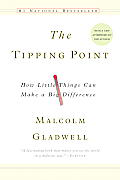Legalized pot. Gay marriage. Charter schools. Tea Party and Occupy. Iggy Azalea and twerking. Hula hoops, school shootings, ebola… what could they possibly have in common? All these things, for better or worse, have popped out of seeming obscurity to enter the everyday fabric of our lives. But what makes something “catch on”? Malcom Gladwell argues that in order to spread through a population, ideas (or diseases, or fads, or fashion, or really anything that is communicated from one person to another) must reach a certain ‘tipping point’ that divides the failures from the successes. However, the things that create a tipping point are probably the things you’d least expect…
“The Tipping Point- How Little Things Can Make A Big Difference”
Review from WikiSummaries
The processes and mechanisms by which some trends achieve exponential popularity while others sputter and fade into oblivion have long been thought to be mysterious and resistant to analysis. However, Gladwell’s central argument is that there are actually a number of patterns and factors that are at play in virtually every influential trend, ranging from the spread of communicable diseases to the unprecedented popularity of a particular children’s television show. If you analyze the evolution of any major phenomenon, the author suggests, you will find that the processes involved are strikingly similar.
Based on his in-depth research spanning a number of different fields, industries, and scholarly disciplines, Gladwell identifies three key factors that each play in role in determining whether a particular trend will “tip” into wide-scale popularity. Gladwell’s discussion and illustration of the concepts of the Law of the Few, the Stickiness Factor, and the Power of Context comprise the majority of the book.
The Law of the Few contends that before widespread popularity can be attained, a few key types of people must champion an idea, concept, or product before it can reach the tipping point. Gladwell describes these key types as Connectors, Mavens, and Salesmen. If individuals representing all three of these groups endorse and advocate a new idea, it is much more likely that it will tip into exponential success.
Gladwell defines the Stickiness Factor as the quality that compels people to pay close, sustained attention to a product, concept, or idea. Stickiness is hard to define, and its presence or absence often depends heavily on context. Often, the way that the Stickiness Factor is generated is unconventional, unexpected, and contrary to received wisdom.
The concept that Gladwell terms the Power of Context is enormously important in determining whether a particular phenomenon will tip into widespread popularity. Even minute changes in the environment can play a major factor in the propensity of a given concept attaining the tipping point. Also, Gladwell defines the term context very broadly, discussing the implications of small variations in social groups and minor changes in a neighborhood or community environment as shifts that can cause a new idea to tip.
After identifying and describing these key concepts, Gladwell dedicates the remainder of the book to illustrating them and their interdependency in a series of compelling case studies and examples. An afterword included in the newest edition of the book updates some of Gladwell’s arguments for more pertinent application in an era of widespread Internet connectivity.











